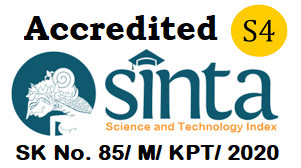Seaweed Supply Chain Risk Mitigation Based on Macroergonomics Perspective Analysis of Structure
Abstract
Indonesia, particularly East Indonesia, accounts for up to 85% of the world's wet seaweeds. Bulukumba is one of Indonesia's most important seaweed producing places. In Babana Hamlet, Bulukumba Regency, 80% of the people is employed as a seaweed grower. Coordination and cooperation between all supply chain actors for seaweed commodities in Bulukumba Regency is required to meet the needs of the market. Poor quality seaweed results in losses to farmers. If this happens, it will result in disruption of the supply chain network, and reduce the profits of the perpetrators. Macroergonomic Structure Analysis (MAS) consists of three main elements of a sociotechnical system, namely the technological subsystem, the personnel subsystem, and the external environment. The only subsystems used were the personnel subsystem and the external environment subsystem. The risk with the highest weight obtained was on the personal subsystem in the professionalism factor with a weight of 0.32 (Motivation decreased during the rainy season). For the external environment factor is a weight of 0.33 (Rainy Season) which is associated with the rainy season. This is because the rainy season has the worst effects. Then the drying process will also be interrupted. The production of seaweed breeders greatly influences the supply chain process. If the risk to seaweed farmers occurs, then the collector traders in carrying out the supply will take longer and the capacity to be transported will also be reduced. The answers found for improvement include picking seeds, acquiring a nursery, acquiring a laboratory, and establishing a landbase to prepare for adverse weather.
References
Ali, M., Stim, P., Mary, S., Ngamal, Y., dan Saint, S., 2021, Pentingnya Manajemen Risiko dalam dunia Pendidikan ( Sekolah ) Selama dan Pasca Covid-19.
Asni, A., 2015, Analisis Produk Rumput Laut (Kappaphycus Alvarezii) Berdasarkan Musim dan Jarak Lokasi Budidaya di Perairan Kabupaten Bantaeng.
Badan Riset Sumber Daya Kelautan dan Perikanan, 2021, Bulukumba Penghasil Rumput Laut Terbesar.
Ilmi, N., 2020, Dampak Peralihan Nelayan Tangkap Menjadi Pembudidaya Rumput Laut Di Kecamatan Ujung Bulu Kabupaten Bulukumba. Social Landscape Journal.
Iriastadi, H. dan Yassirli, 2014, Ergonomi Suatu Pengantar. Rosda Jaya Putra.
Indahsari, R., Rosdiana, Y., dan Lestari, R., 2018, Pengaruh Penerapan Manajemen Risiko terhadap Kinerja Organisasi pada Lembaga Perbankan Syariah di Kota Bandung, vol 19, No 1.
Keith Blacker, P. M., 2016, People Risk Management A Practical Approach to Managing the Human Factors That Could Harm Your Business. Kogan Page.
Kementerian Perindustrian, 2018, Pemasok Rumput Laut Dunia.
Kurniasari, A., 2017, Analisis Ergonomi Pada Kapal Selam Mini.
Kurniawan, R., Hasibuan, S., dan Nugroho, R. E., 2017, Analisis Kriteria dan Proses Seleksi Kontraktor Chemical Sektor Hulu Migas: Aplikasi Metode Delphi-AHP, MIX: Jurnal Ilmiah Manajemen.
Widyanto, A., 2012, Peran Supply Chain Management Measusrment Hingga Strategy Focused Organization, Jurnal Manajemen Bisnis, hal 91-98.

This work is licensed under a Creative Commons Attribution-NonCommercial-ShareAlike 4.0 International License.













